ORACLE 11G OCP 管理2 WorkshopII 1Z0-053 题库100-200之间题
- 格式:docx
- 大小:766.61 KB
- 文档页数:47
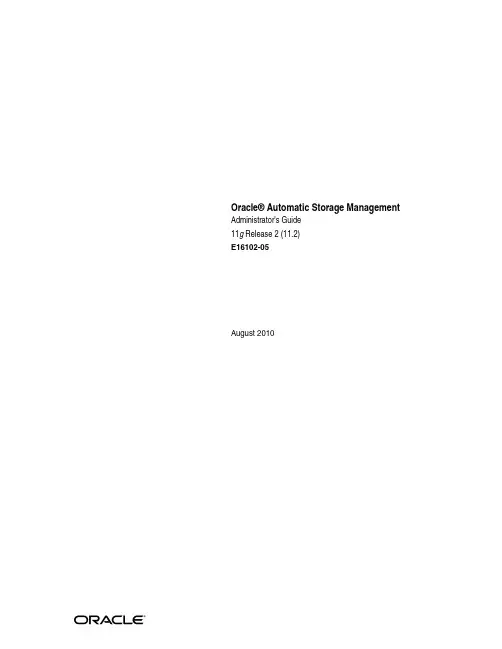
Oracle® Automatic Storage Management Administrator's Guide11g Release 2 (11.2)E16102-05August 2010Oracle Automatic Storage Management Administrator's Guide, 11g Release 2 (11.2)E16102-05Copyright © 2007, 2010, Oracle and/or its affiliates. All rights reserved.Contributing Authors: Jerry Abraham, Prasad Bagal, Mark Bauer, Eric Belden, Bill Bridge, Chan Chan, Xiaobin Chen, Hanlin Chien, Jonathan Creighton, Steve Fogel, Dave Friedman, Barb Glover, Fred Glover, Allan Graves, Shie-rei Huang, Rekha Iyer, Diane Lebel, Rich Long, Colin McGregor, Gregory Mengel, Harendra Mishra, Valarie Moore, Nitin Munjal, Darshan Nagarajappa, Harish Nandyala, Bob Nelson, Balaji Pagadala, Satish Panchumarthy, Soma Prasad, Kathy Rich, Harshavardhan Sabbineni, Francisco Sanchez, Santhosh Selvaraj, Ara Shakian, Duane Smith, Joshua Smith, Malai Stalin, Amar Subba, Yaser Suleiman, Elisabeth Thibault, Michael Timpanaro-Perrotta, Samarjeet Tomar, Brian Tsao, Nitin Vengurlekar, P Venkatraman, Anton Verhulst, Radek Vingralek, Ron Weiss, Ric Werme, Rajiv Wickremesinghe, Jim A. Williams, Sivakumar Yarlagadda, Song Ye, Krishnan Yegnashankaran, Hector Yuen, Jon ZollaThis software and related documentation are provided under a license agreement containing restrictions on use and disclosure and are protected by intellectual property laws. Except as expressly permitted in your license agreement or allowed by law, you may not use, copy, reproduce, translate, broadcast, modify, license, transmit, distribute, exhibit, perform, publish, or display any part, in any form, or by any means. Reverse engineering, disassembly, or decompilation of this software, unless required by law for interoperability, is prohibited.The information contained herein is subject to change without notice and is not warranted to be error-free. If you find any errors, please report them to us in writing.If this software or related documentation is delivered to the U.S. Government or anyone licensing it on behalf of the U.S. Government, the following notice is applicable:U.S. GOVERNMENT RIGHTS Programs, software, databases, and related documentation and technical data delivered to U.S. Government customers are "commercial computer software" or "commercial technical data" pursuant to the applicable Federal Acquisition Regulation and agency-specific supplemental regulations. As such, the use, duplication, disclosure, modification, and adaptation shall be subject to the restrictions and license terms set forth in the applicable Government contract, and, to the extent applicable by the terms of the Government contract, the additional rights set forth in FAR 52.227-19, Commercial Computer Software License (December 2007). Oracle USA, Inc., 500 Oracle Parkway, Redwood City, CA 94065.This software is developed for general use in a variety of information management applications. It is not developed or intended for use in any inherently dangerous applications, including applications which may create a risk of personal injury. If you use this software in dangerous applications, then you shall be responsible to take all appropriate fail-safe, backup, redundancy, and other measures to ensure the safe use of this software. Oracle Corporation and its affiliates disclaim any liability for any damages caused by use of this software in dangerous applications.Oracle is a registered trademark of Oracle Corporation and/or its affiliates. Other names may be trademarks of their respective owners.This software and documentation may provide access to or information on content, products, and services from third parties. Oracle Corporation and its affiliates are not responsible for and expressly disclaim all warranties of any kind with respect to third-party content, products, and services. Oracle Corporation and its affiliates will not be responsible for any loss, costs, or damages incurred due to your access to or use of third-party content, products, or services.ContentsPreface (xxiii)Audience (xxiii)Documentation Accessibility (xxiii)Related Documents (xxiv)Conventions (xxiv)What's New in Oracle Automatic Storage Management? (xxv)Oracle Automatic Storage Management 11g Release 2 (11.2.0.2) New Features (xxv)Oracle Automatic Storage Management 11g Release 2 (11.2.0.1) New Features (xxvii)Oracle Automatic Storage Management 11g Release 1 (11.1) New Features (xxx)1 Introduction to Oracle Automatic Storage ManagementOverview of Oracle Automatic Storage Management...................................................................... 1-1 Understanding Oracle ASM Concepts................................................................................................. 1-2 About Oracle ASM Instances........................................................................................................... 1-2 About Oracle ASM Disk Groups..................................................................................................... 1-5 About Mirroring and Failure Groups............................................................................................. 1-5 About Oracle ASM Disks.................................................................................................................. 1-6 Allocation Units ......................................................................................................................... 1-7 About Oracle ASM Files.................................................................................................................... 1-7 Extents.......................................................................................................................................... 1-7Oracle ASM Striping................................................................................................................... 1-8File Templates...........................................................................................................................1-10 Understanding Oracle ASM Disk Group Administration............................................................1-10 About Discovering Disks...............................................................................................................1-10 About Mounting and Dismounting Disk Groups......................................................................1-11 About Adding and Dropping Disks.............................................................................................1-11 About Online Storage Reconfigurations and Dynamic Rebalancing......................................1-11 2 Considerations for Oracle ASM StorageStorage Resources for Disk Groups...................................................................................................... 2-1 Oracle ASM and Multipathing.............................................................................................................. 2-3 Recommendations for Storage Preparation........................................................................................ 2-4iii3 Administering Oracle ASM InstancesOperating with Different Releases of Oracle ASM and Database Instances Simultaneously. 3-1 Configuring Initialization Parameters for Oracle ASM Instances................................................. 3-2 Initialization Parameter Files for an Oracle ASM Instance.......................................................... 3-3 Backing Up, Copying, and Moving an Oracle ASM Initialization Parameter File................... 3-4 Setting Oracle ASM Initialization Parameters............................................................................... 3-5 Automatic Memory Management for Oracle ASM............................................................... 3-5 Oracle ASM Parameter Setting Recommendations....................................................................... 3-6 ASM_DISKGROUPS................................................................................................................... 3-7ASM_DISKSTRING.................................................................................................................... 3-7ASM_POWER_LIMIT................................................................................................................ 3-8ASM_PREFERRED_READ_FAILURE_GROUPS.................................................................. 3-9DB_CACHE_SIZE....................................................................................................................... 3-9DIAGNOSTIC_DEST...............................................................................................................3-10INSTANCE_TYPE....................................................................................................................3-10LARGE_POOL_SIZE...............................................................................................................3-10PROCESSES..............................................................................................................................3-10REMOTE_LOGIN_PASSWORDFILE...................................................................................3-11SHARED_POOL_SIZE............................................................................................................3-11 Setting Database Initialization Parameters for Use with Oracle ASM....................................3-11 Managing Oracle ASM Instances.......................................................................................................3-12 Administering Oracle ASM Instances with Server Control Utility.........................................3-12 Using Oracle Restart.......................................................................................................................3-13 Starting Up an Oracle ASM Instance............................................................................................3-13 About Mounting Disk Groups at Startup.............................................................................3-15About Restricted Mode...........................................................................................................3-15 Shutting Down an Oracle ASM Instance.....................................................................................3-16 Upgrading an Oracle ASM Instance with Oracle Universal Installer.....................................3-17 Downgrading an Oracle ASM Instance.......................................................................................3-19 Out of Place Upgrades....................................................................................................................3-22 Configuring Oracle Grid Infrastructure with the Configuration Wizard...............................3-22 Active Session History Sampling for Oracle ASM.....................................................................3-22 Using Oracle ASM Rolling Upgrade.................................................................................................3-22 Patching Oracle ASM Instances in Oracle RAC Environments...................................................3-23 Authentication for Accessing Oracle ASM Instances....................................................................3-23 About Privileges for Oracle ASM.................................................................................................3-24 Using One Operating System Group for Oracle ASM Users............................................3-24Using Separate Operating System Groups for Oracle ASM Users...................................3-25The SYSASM Privilege for Administering Oracle ASM....................................................3-26The SYSDBA Privilege for Managing Oracle ASM Components.....................................3-27 Creating Users with the SYSASM Privilege................................................................................3-27 Operating System Authentication for Oracle ASM ...................................................................3-28 Password File Authentication for Oracle ASM ..........................................................................3-28 Migrating a Database to Use Oracle ASM........................................................................................3-29 Using Oracle Enterprise Manager to Migrate Databases to Oracle ASM...............................3-29 Using Oracle Recovery Manager to Migrate Databases to Oracle ASM.................................3-29 Best Practices White Papers on Migrating to Oracle ASM........................................................3-29 iv4 Administering Oracle ASM Disk GroupsDisk Group Attributes............................................................................................................................ 4-2 Creating Disk Groups............................................................................................................................. 4-3 Using the CREATE DISKGROUP SQL Statement........................................................................ 4-3 Example: Creating a Disk Group..................................................................................................... 4-5 Creating Disk Groups for a New Oracle Installation.................................................................... 4-6 Specifying the Allocation Unit Size................................................................................................. 4-7 Specifying the Sector Size for Drives............................................................................................... 4-8 Oracle Cluster Registry and Voting Files in Oracle ASM Disk Groups..................................4-10 Altering Disk Groups...........................................................................................................................4-11 Managing Volumes in a Disk Group............................................................................................4-12 Adding Disks to a Disk Group......................................................................................................4-13 Adding Disks to a Disk Group with SQL Statements........................................................4-13 Dropping Disks from Disk Groups..............................................................................................4-14 Intelligent Data Placement.............................................................................................................4-15 Resizing Disks in Disk Groups......................................................................................................4-16 Undropping Disks in Disk Groups...............................................................................................4-17 Manually Rebalancing Disk Groups............................................................................................4-17 Tuning Rebalance Operations.......................................................................................................4-18 Oracle ASM Disk Discovery ..............................................................................................................4-19 How A Disk is Discovered.............................................................................................................4-19 Disk Discovery Rules......................................................................................................................4-20 Improving Disk Discovery Time...................................................................................................4-21 Managing Capacity in Disk Groups..................................................................................................4-21 Negative Values of USABLE_FILE_MB.......................................................................................4-23 Oracle ASM Mirroring and Disk Group Redundancy..................................................................4-23 Mirroring, Redundancy, and Failure Group Options...............................................................4-23 Oracle ASM Failure Groups...................................................................................................4-25How Oracle ASM Manages Disk Failures............................................................................4-25Guidelines for Using Failure Groups....................................................................................4-25Failure Group Frequently Asked Questions........................................................................4-26 Oracle ASM Recovery from Read and Write I/O Errors..........................................................4-26 Oracle ASM Fast Mirror Resync...................................................................................................4-27 Preferred Read Failure Groups.....................................................................................................4-29 Configuring and Administering Preferred Read Failure Groups....................................4-30 Performance and Scalability Considerations for Disk Groups....................................................4-31 Determining the Number of Disk Groups...................................................................................4-31 Performance Characteristics When Grouping Disks.................................................................4-31 Oracle ASM Storage Limits...........................................................................................................4-31 Disk Group Compatibility..................................................................................................................4-32 Overview of Disk Group Compatibility......................................................................................4-32 Disk Group Compatibility Attributes..........................................................................................4-33 COMPATIBLE.ASM................................................................................................................4-33COMPATIBLE.RDBMS...........................................................................................................4-34COMPATIBLE.ADVM............................................................................................................4-34 Setting Disk Group Compatibility Attributes.............................................................................4-34 Valid Combinations of Compatibility Attribute Settings..................................................4-35vUsing CREATE DISKGROUP with Compatibility Attributes..........................................4-36Using ALTER DISKGROUP with Compatibility Attributes.............................................4-36Viewing Compatibility Attribute Settings...........................................................................4-36Features Enabled By Disk Group Compatibility Attribute Settings................................4-37Reverting Disk Group Compatibility....................................................................................4-37 Considerations When Setting Disk Group Compatibility in Replicated Environments......4-38 Managing Oracle ASM File Access Control for Disk Groups......................................................4-39 About Oracle ASM File Access Control.......................................................................................4-40 Using SQL Statements to Set Disk Group Attributes for Oracle ASM File Access Control.4-41 Using SQL Statements to Manage Oracle ASM File Access Control.......................................4-42 Mounting and Dismounting Disk Groups......................................................................................4-43 Mounting Disk Groups Using the FORCE Option.....................................................................4-44 Checking the Internal Consistency of Disk Group Metadata......................................................4-45 Dropping Disk Groups........................................................................................................................4-45 Renaming Disks Groups......................................................................................................................4-46 5Introduction to Oracle ACFSOverview of Oracle ACFS...................................................................................................................... 5-1 Understanding Oracle ACFS Concepts................................................................................................ 5-4 About Oracle ACFS............................................................................................................................ 5-4 About Oracle ACFS and Oracle Database Homes........................................................................ 5-5 About Oracle ASM Dynamic Volume Manager............................................................................ 5-6 About the Oracle ACFS Driver Model............................................................................................ 5-6 About the Oracle ACFS Mount Model and Namespace.............................................................. 5-7 About the Oracle ACFS Mount Registry........................................................................................ 5-7 About Oracle ACFS Snapshots......................................................................................................... 5-8 About Oracle ACFS and Backup and Restore................................................................................ 5-8 About Oracle ACFS Integration with Oracle ASM....................................................................... 5-9 Understanding Oracle ACFS Administration.................................................................................... 5-9 Oracle ACFS and File Access and Administration Security........................................................ 5-9 Oracle ACFS and Grid Infrastructure Installation.....................................................................5-10 Oracle ACFS and Grid Infrastructure Configuration................................................................5-10 Clusterware Resources and Oracle ACFS Administration.......................................................5-10 Oracle ACFS and Dismount or Shutdown Operations.............................................................5-11 Oracle ACFS Security.....................................................................................................................5-12 Oracle ACFS Encryption................................................................................................................5-14 Oracle ACFS Replication................................................................................................................5-16 Oracle ACFS Tagging.....................................................................................................................5-18 Overview of Oracle ASM Dynamic Volume Manager..................................................................5-18 6Using Views to Display InformationViews Containing Oracle ASM Disk Group Information............................................................... 6-1 Viewing Oracle ASM File Access Control Information................................................................ 6-4 Viewing Disk Region Information................................................................................................... 6-5 Views Containing Oracle ACFS Information..................................................................................... 6-6 vi7 Administering Oracle ASM Files, Directories, and TemplatesWhat Types of Files Does Oracle ASM Support?.............................................................................. 7-1 About Oracle ASM Filenames............................................................................................................... 7-2 Single File Creation Form................................................................................................................. 7-3 Multiple File Creation Form............................................................................................................. 7-4 Fully Qualified File Name Form...................................................................................................... 7-4 Alias Oracle ASM Filename Forms................................................................................................. 7-5 Creating a Tablespace in Oracle ASM: Using a Data File with an Alias Name................. 7-6 Alias Oracle ASM Filename with Template Form........................................................................ 7-6 Incomplete Oracle ASM Filename Form........................................................................................ 7-7 Incomplete Oracle ASM Filename with Template Form.............................................................. 7-7 Creating and Referencing Oracle ASM Files in the Database........................................................ 7-7 Creating Oracle ASM Files Using a Default File Location for Disk Group Specification....... 7-8 Using Oracle ASM Filenames in SQL Statements......................................................................... 7-9 Managing Alias Names for Oracle ASM Filenames......................................................................... 7-9 Adding an Alias Name for an Oracle ASM Filename...............................................................7-10 Renaming an Alias Name for an Oracle ASM Filename...........................................................7-10 Dropping an Alias Name for an Oracle ASM Filename............................................................7-10 Dropping Files and Associated Aliases from a Disk Group.....................................................7-10 Managing Disk Group Directories....................................................................................................7-11 Creating a New Directory..............................................................................................................7-11 Renaming a Directory.....................................................................................................................7-12 Dropping a Directory.....................................................................................................................7-12 Accessing Oracle ASM Files with the XML DB Virtual Folder...................................................7-12 Inside /sys/asm..............................................................................................................................7-13 Using DBMS_FILE Transfer Utility for Oracle ASM.....................................................................7-14 Managing Disk Group Templates......................................................................................................7-15 Template Attributes........................................................................................................................7-15 Adding Templates to a Disk Group.............................................................................................7-17 Modifying a Disk Group Template..............................................................................................7-17 Dropping Templates from a Disk Group....................................................................................7-18 Creating Tablespaces in Oracle ASM: Specifying Attributes with Templates.......................7-18 8 Performing Oracle ASM Data Migration with RMANOverview of Oracle ASM Data Migration.......................................................................................... 8-1 Purpose of Oracle ASM Data Migration......................................................................................... 8-1 Basic Concepts of Oracle ASM Data Migration............................................................................. 8-2 Basics Steps of Data Migration to Oracle ASM Using RMAN.................................................... 8-2 Preparing to Migrate the Database to Oracle ASM Using RMAN................................................. 8-3 Migrating the Database to Oracle ASM Using RMAN.................................................................... 8-5 Migrating a Database from Oracle ASM to Alternative Storage.................................................... 8-9 Moving Data Files Between Oracle ASM Disk Groups Using RMAN......................................... 8-9 9 Administering Oracle ASM with Oracle Enterprise ManagerOracle Automatic Storage Management Home Page........................................................................ 9-1 Accessing the Oracle ASM Home Page in Single-Instance Oracle Databases ......................... 9-2vii。
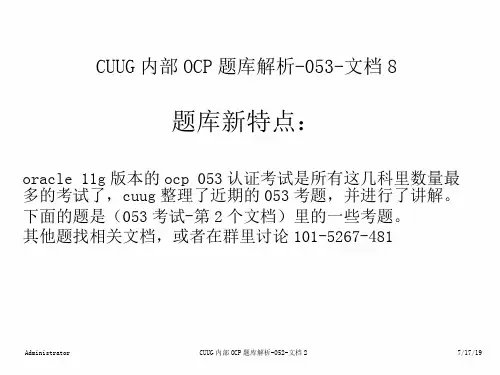
CUUG内部OCP题库解析-053-文档8题库新特点:oracle 11g版本的ocp053认证考试是所有这几科里数量最多的考试了,cuug整理了近期的053考题,并进行了讲解。
下面的题是(053考试-第2个文档)里的一些考题。
其他题找相关文档,或者在群里讨论101-5267-481Administrator CUUG内部OCP题库解析-052-文档27/17/1981.Evaluate the following command and its output:SQL>SELECT * FROM dba_temp_free_space;TABLESPACE_NAME TABLESPACE_SIZE ALLOCATED_SPACE FREE_SPACETEMP 250609664 101048576 149561088Which two statements correctly interpret the output? (Choose two.)A. FREE_SPACE indicates only the space that is currently unallocated.B. ALLOCATED_SPACE indicates only the space currently allocated and in use.C. FREE_SPACE indicates only the space that is currently allocated and available for reuse.D. ALLOCATED_SPACE indicates both the space currently allocated and used, and the space that is available for reuse.E. FREE_SPACE indicates both the space that is currently allocated and available for reuse, and the space that is currently unallocated.Answer: DE考点:临时表空间的空间是共享的,当一个事物完成后,原来所占的空间就会释放,允许给其它事务使用。
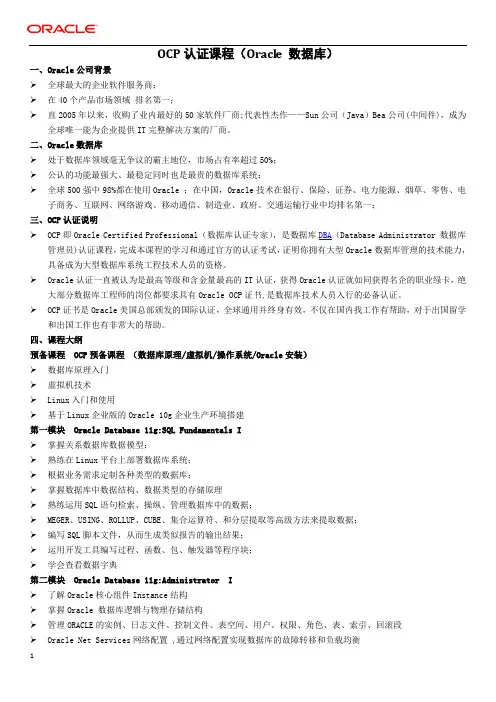
OCP认证课程(Oracle 数据库)一、Oracle公司背景全球最大的企业软件服务商;在40个产品市场领域排名第一;直2005年以来,收购了业内最好的50家软件厂商;代表性杰作——Sun公司(Java)Bea公司(中间件),成为全球唯一能为企业提供IT完整解决方案的厂商。
二、Oracle数据库处于数据库领域毫无争议的霸主地位,市场占有率超过50%;公认的功能最强大、最稳定同时也是最贵的数据库系统;全球500强中98%都在使用Oracle ;在中国,Oracle技术在银行、保险、证券、电力能源、烟草、零售、电子商务、互联网、网络游戏、移动通信、制造业、政府、交通运输行业中均排名第一;三、OCP认证说明管理员)认证课程,完成本课程的学习和通过官方的认证考试,证明你拥有大型Oracle数据库管理的技术能力,具备成为大型数据库系统工程技术人员的资格。
Oracle认证一直被认为是最高等级和含金量最高的IT认证,获得Oracle认证就如同获得名企的职业绿卡,绝大部分数据库工程师的岗位都要求具有Oracle OCP证书,是数据库技术人员入行的必备认证。
OCP证书是Oracle美国总部颁发的国际认证,全球通用并终身有效,不仅在国内找工作有帮助,对于出国留学和出国工作也有非常大的帮助。
四、课程大纲预备课程 OCP预备课程(数据库原理/虚拟机/操作系统/Oracle安装)数据库原理入门虚拟机技术Linux入门和使用基于Linux企业版的Oracle 10g企业生产环境搭建第一模块 Oracle Database 11g:SQL Fundamentals I掌握关系数据库数据模型;熟练在Linux平台上部署数据库系统;根据业务需求定制各种类型的数据库;掌握数据库中数据结构、数据类型的存储原理熟练运用SQL语句检索、操纵、管理数据库中的数据;MEGER、USING、ROLLUP、CUBE、集合运算符、和分层提取等高级方法来提取数据;编写SQL脚本文件,从而生成类似报告的输出结果;运用开发工具编写过程、函数、包、触发器等程序块;学会查看数据字典第二模块 Oracle Database 11g:Administrator I了解Oracle核心组件Instance结构掌握Oracle 数据库逻辑与物理存储结构管理ORACLE的实例、日志文件、控制文件、表空间、用户、权限、角色、表、索引、回滚段Oracle Net Services网络配置 ,通过网络配置实现数据库的故障转移和负载均衡配置应用程序数据库使用基本监视过程实施备份和恢复策略在数据库和文件之间移动数据第三模块 Oracle Database 11g:Administrator II 学习内容创建一个能正常运行的数据库,以及如何以有效和高效的方式来正确管理各种不同的结构,从而构造出一个设计良好、高效率运行的数据库如何实施数据库安全使用资源管理器管理资源、作业调度、安全性和全球化问题根据业务需求,制定与完善数据库的备份、恢复、和RECOVER等策略执行数据库备份、恢复策略的计划与实施等关键任务,以及如何进行正确性的验证根据实际数据库的十几种不同的损坏原因,采用不同的恢复方式熟练掌握Recovery Manager工具来执行备份、恢复、执行块修复使用脚本在内存、性能和存储方面,进行数据库监视操作五、课程目标完成课程学习后学员将具备通过OCP考试的能力,成为Oracle公司认可Oracle数据库专家;进入企业后可具备独立管理10G-100G的Oracle数据库的能力,包括进行一定的数据库开发、在多数备份恢复场景下的决策能力,能够对常见数据库性能问题作出优化、加固完善数据库安全性;能够管理注册用户上百万,每日交易额上千万的电子商务网站的核心数据库。
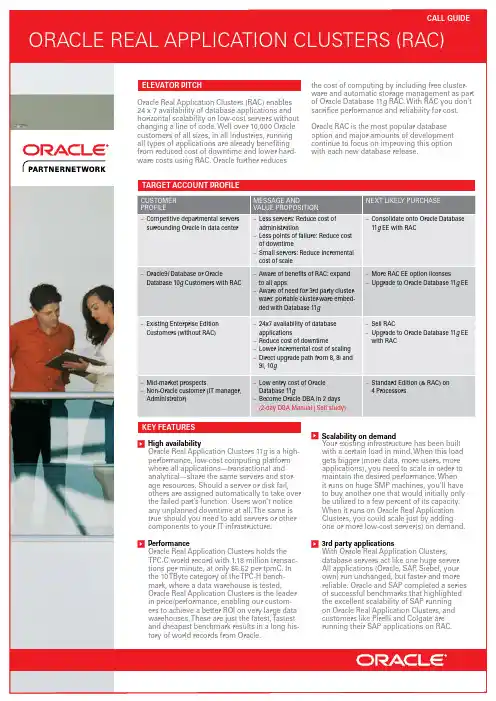

整理过程参考了一末夕阳的博客,复习过程的心得是,一百题看完复习前一部分,同时我还整理了一份打印版本的,上面只有题目,没有答案,建议在电脑上先看答案整理那一份,没有答案的那份打印出来,复习使用,可以有效加强记忆。
1.While deploying a new application module, the software vendor ships the application software along with appropriate SQL plan baselines for the new SQLs being introduced。
Which two statements describe the consequences? (Choose two.)A。
The plan baselines can be evolved over time to produce better performance。
B. The newly generated plans are directly placed into the SQL plan baseline without being verified。
C。
The new SQL statements initially run with the plans that are known to produce good performance under standard test configuration.D. The optimizer does not generate new plans for the SQL statements for which the SQL plan baseline has been imported.当部署一个新的应用模块时,软件供应商与用于被引入的新SQL的适当的SQL计划基线一起运送应用软件。
哪两个语句描述了后果?A,计划基线可以随着时间的推移演变,产生更好的性能。
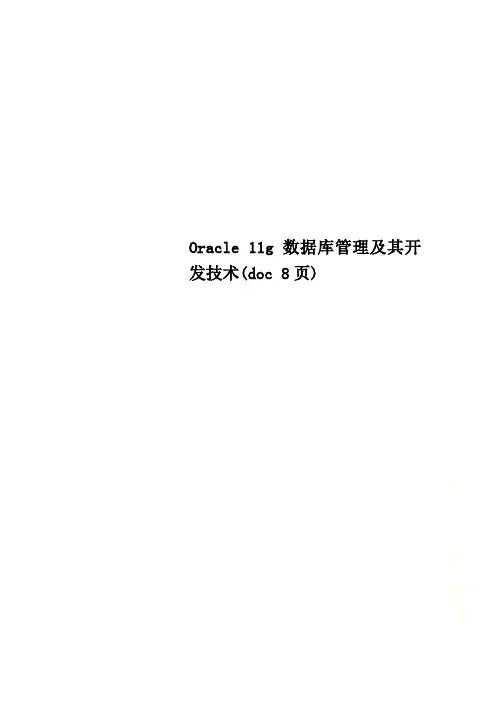
Oracle 11g数据库管理及其开发技术(doc 8页)课程摘要:本课程主要介绍Oracle数据库的基本概念、安装方法及数据库的启动与关闭、与数据库设计、开发和管理密切相关的SQL语言,以及Oracle对SQL语言应用进行增强的PLSQL语言和SQL*Plus管理工具,并结合大量的实例帮助学员学习Oracle数据库系统的相关知识;数据库的备份与恢复技术,包括基础知识、RMAN工具、闪回、OEN 及逻辑备份工具(数据泵技术)、数据库优化、SQL优化和系统调整方面的知识;内容大纲:数据库的基础知识数据库的产生、数据库的特征数据库的组成、数据库的管理系统、关系数据库初识OracleOracle 数据库系统的特点、发展历史Oracle 版本号的含义、Oracle 11g 的新特性Oracle 11g 数据库安装/启动/关闭Oracle 11g 在Windows 下的安装概述在Windows 环境下安装Oracle 11g在Linux 环境下安装前的准备、在Linux 环境下安装Oracle 11gOracle 11g 数据库实例的创建在Windows 环境下创建数据库 在Linux 环境下用DBCA 创建数据库Oracle 11g 实例启动与关闭Linux 环境下Oracle 实例的关闭、Linux 环境下Oracle 监听进程的启动和关闭SQL 语言概述使用SQL*Plus用SQL*Plus 与数据库交互SQL*Plus 的主要功能、启动SQL*Plus 连接数据库1. 管理表建表时的考量、列数据类型、创建表的语法、创建表的实例、查看表的信息、修改表结构、重命名表、监控表的存储空间、修改表空间的存储设置、删除表、外部表的管理1.索引概念、各种类型索引的比较和选择、索引基本操作1.视图概念、视图基本操作、同义词、序列2.表分区与索引分区1.分区技术概述2.表分区方法说明及实例范围分区(Range)、散列(Hash)分区、列表分区(List)、组合分区、Interval分区、外键分区、虚拟列分区、表的分区策略、管理表分区表分区管理操作列表、表分区管理操作实例用户管理与安全数据完整和数据约束什么是事务数据并行性和一致性、Oracle如何管理数据并行性和一致性锁锁的功能、分类及类型、表锁和事务锁、检测和解决锁冲突、实例分析数据完整性数据完整性概述、完整性约束、完整性约束类型、约束检验机制、约束状态备份与恢复备份与恢复概述备份分类与恢复分类备份分类、恢复分类备份与恢复方法Oracle 11g的备份和恢复特性使用RMAN工具RMAN简介、RMAN资料档案库/恢复目录/控制文件、创建恢复目录RMAN与数据库的连接连接到目标数据库、连接到恢复目录注册数据库注册目标数据库、实例演示通道分配通道概述、 RUN命令介绍、自动通道配置、手动通道配置、显示通道配置参数、设置通道控制参数使用BACKUP命令生成备份集备份集与备份片、BACKUP命令语法、备份文件的存储格式、BACKUP备份实例、BACKUP 的冷备份与热备份Oracle 11g的备份和恢复特性使用COPY与BACK AS COPY命令COPY命令语法、COPY备份实例、BACKUP AS COPY命令备份压缩备份、完全备份与递增备份、查看备份信息使用RMAN恢复数据库RESTORE命令、RECOVER命令、实例解析Oracle闪回技术(Flashback)使用OEM向导备份和恢复数据库逻辑备份/数据导入导出数据泵技术概述创建目录对象使用Data Pump导出数据Data Pump导出说明、基于命令行数据泵导出实例、基于DBMS_DATAPUMP数据泵导出实例使用Data Pump导入数据Data Pump导入说明、基于命令行数据泵导入实例、基于DBMS_DATAPUMP数据泵导入实例监控Data Pump作业进度EXP/IMP导出导入数据EXP/IMP概要说明、EXP导出实例、IMP导入实例Oracle SQL语句优化一般的SQL技巧建议不用“*”来代替所有列名、用TRUNCATE代替DELETE、在确保完整性的情况下多用COMMIT语句、尽量减少表的查询次数、用NOT EXISTS替代NOT IN、用EXISTS替代IN、用EXISTS替代DISTINCT表的连接方法选择FROM表的顺序、驱动表的选择、WHERE子句的连接顺序有效使用索引何时使用索引、索引列和表达式的选择、选择复合索引主列、避免对大表的全表扫描、监视索引是否被使用Oracle的优化器与执行计划优化器概念、运行EXPLAIN PLAN、Oracle 11g中SQL执行计划的管理Oracle 11g中的执行计划管理执行计划管理的工作原理、执行计划管理的测试、执行计划管理实例测试Oracle 11g中的数据库重演和SQL重演数据库重演、SQL重演Oracle系统调整1.Oracle初始化参数文件2.Oracle动态视图3. Oracle SGA 调整理解内存分配、调整日志缓冲区分配、调整共享池分配、调整数据库缓冲区、SGA 调整建议排序区调整排序区与其他内存区的关系、理解排序活动、监视排序活动、专用模式下排序区的调整、共享模式下排序区的调整Oracle 11g 中的自动内存优化功能客户化安装、设置与安装数据库控制、启动Oracle 11g EM 、登录到Oracle 11g EM 用Oracle 11g EM 管理Oracle 系统数据库配置管理、方案管理、数据文件管理、数据库用户管理用EM 维护Oracle 系统执行导出操作、管理(本地)表空间、浏览预警文件信息用Oracle 11g EM 进行性能调整查看顶级活动、监视Oracle 实例是否存在锁学时学费: ◆ 学时:共 56 学时 白班:共 7 天 晚班:共14天 ◆培训费用每人4200元,四人以上团体学习或专家上门培训优惠多多,具体请电话咨询。
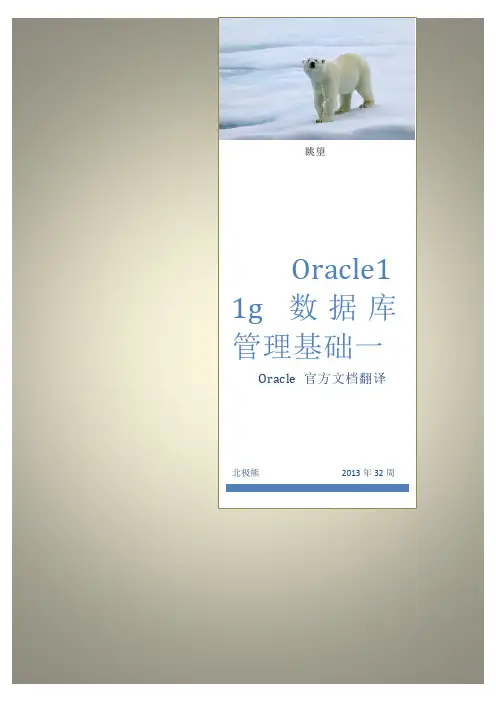
[键入文字]眺望Oracle1 1g 数据库管理基础一Oracle 官方文档翻译北极熊2013年32周 (1)1开始数据库管理 (2)1.1各种Oracle数据库用户 (2)1.1.1数据库管理员 (2)1.1.2安全人员 (2)1.1.3网络管理员 (3)1.1.4应用开发者 (3)1.1.5应用管理者 (3)1.1.6数据库用户 (3)1.2数据库管理员的任务 (3)1.2.1评估数据库服务器硬件 (3)1.2.2安装数据库软件 (4)1.2.3规划数据库 (4)1.2.4建立并打开数据库 (4)1.2.5备份数据库 (4)1.2.6登记系统用户 (4)1.2.7实现数据库设计 (5)1.2.8备份完整功能的数据库 (5)1.2.9调优数据库性能 (5)1.2.10下载并安装补丁 (5)1.2.11滚动安装到附加主机 (5)1.3在数据库中运行命令和SQL (6)1.3.1关于SQL*Plus (6)1.3.2使用SQL连接到数据库 (6)1.4标识你的数据库发行版本 (9)1.4.1检查当前版本号 (9)1.5关于数据管理员安全与权限 (10)1.5.1数据库管理员的操作系统账号: (10)1.5.2管理员账号: (10)1.6数据库管理员认证 (10)1.6.1管理员权限 (10)1.6.2SYSDBA和SYSOPER (11)1.6.3作为SYSDBA连接的例子 (11)1.6.4选择数据库管理员认证方法 (12)1.7建立和维护密码文件 (13)1.7.1建立密码文件 (13)1.7.2密码文件参数描述 (14)共享和禁用密码文件 (14)1.7.4保持管理员密码和数据字典同步 (15)1.7.5管理密码文件 (15)1.8数据工具 (15)1.8.1SQL*Loader (15)1.8.2Export和Import 工具 (16)本章真正的很基础,很基础。
说实话翻译时就感觉是练习练习英文,有点基础都跳过或是有选择的看一点吧。
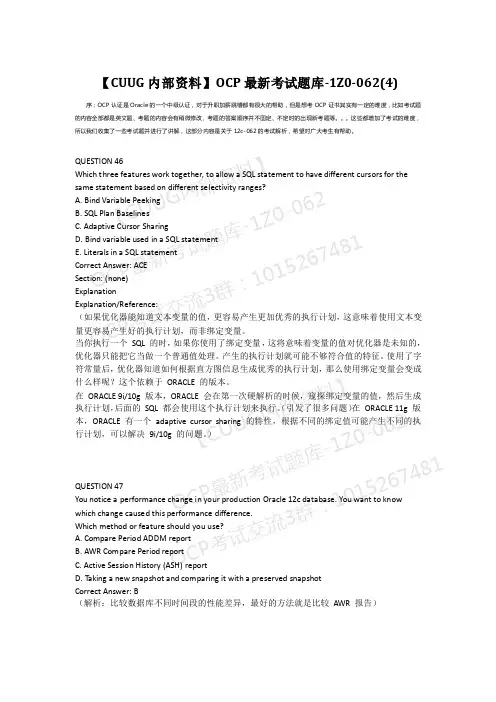
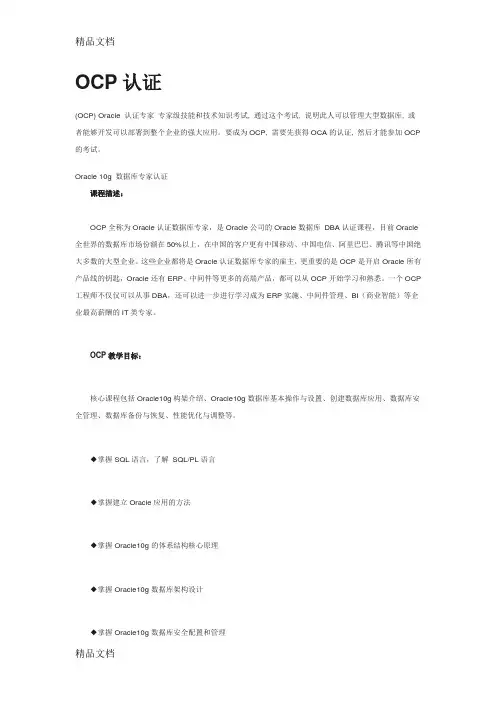
OCP认证(OCP) Oracle 认证专家专家级技能和技术知识考试, 通过这个考试, 说明此人可以管理大型数据库, 或者能够开发可以部署到整个企业的强大应用。
要成为OCP, 需要先获得OCA的认证, 然后才能参加OCP 的考试。
Oracle 10g 数据库专家认证课程描述:OCP全称为Oracle认证数据库专家,是Oracle公司的Oracle数据库DBA认证课程,目前Oracle 全世界的数据库市场份额在50%以上,在中国的客户更有中国移动、中国电信、阿里巴巴、腾讯等中国绝大多数的大型企业。
这些企业都将是Oracle认证数据库专家的雇主,更重要的是OCP是开启Oracle所有产品线的钥匙,Oracle还有ERP、中间件等更多的高端产品,都可以从OCP开始学习和熟悉。
一个OCP 工程师不仅仅可以从事DBA,还可以进一步进行学习成为ERP实施、中间件管理、BI(商业智能)等企业最高薪酬的IT类专家。
OCP教学目标:核心课程包括Oracle10g构架介绍、Oracle10g数据库基本操作与设置、创建数据库应用、数据库安全管理、数据库备份与恢复、性能优化与调整等。
◆掌握SQL语言,了解SQL/PL语言◆掌握建立Oracle应用的方法◆掌握Oracle10g的体系结构核心原理◆掌握Oracle10g数据库架构设计◆掌握Oracle10g数据库安全配置和管理◆掌握Oracle10g数据库逻辑和物理备份恢复方法◆掌握Oracle10g数据库的出错调试技术◆掌握Oracle10g数据库的RMAN恢复技术Oracle 10g OCP官方课程列表:Oracle Database 10g: SQL FundamentalsOracle Database 10g: Administration Workshop IOracle Database 10g: Administration Workshop IIOracle 考试以下是考OCA的认证条件(以下是OCA的两门考试科目)现在OCA认证版本已经升级到10g考试科目为:Oracle Database 10g: SQL Fundamentals 考试代码:1Z0-047 考试费用:$125Oracle Database 10g: Administration Workshop I 考试代码:1Z0-042 考试费用:$125要获得OCA证书,只需要在Pearson vue考试中心通过考试就可以获得Oracle公司发放的OCA认证。
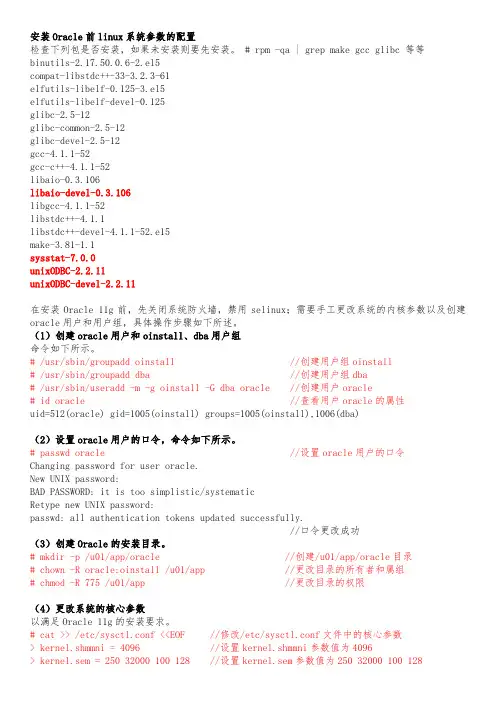
安装Oracle前linux系统参数的配置检查下列包是否安装,如果未安装则要先安装。
# rpm -qa | grep make gcc glibc 等等binutils-2.17.50.0.6-2.el5compat-libstdc++-33-3.2.3-61elfutils-libelf-0.125-3.el5elfutils-libelf-devel-0.125glibc-2.5-12glibc-common-2.5-12glibc-devel-2.5-12gcc-4.1.1-52gcc-c++-4.1.1-52libaio-0.3.106libaio-devel-0.3.106libgcc-4.1.1-52libstdc++-4.1.1libstdc++-devel-4.1.1-52.e15make-3.81-1.1sysstat-7.0.0unixODBC-2.2.11unixODBC-devel-2.2.11在安装Oracle 11g前,先关闭系统防火墙,禁用selinux;需要手工更改系统的内核参数以及创建oracle用户和用户组,具体操作步骤如下所述。
(1)创建oracle用户和oinstall、dba用户组命令如下所示。
# /usr/sbin/groupadd oinstall //创建用户组oinstall# /usr/sbin/groupadd dba //创建用户组dba# /usr/sbin/useradd -m -g oinstall -G dba oracle //创建用户oracle# id oracle //查看用户oracle的属性uid=512(oracle) gid=1005(oinstall) groups=1005(oinstall),1006(dba)(2)设置oracle用户的口令,命令如下所示。
# passwd oracle //设置oracle用户的口令Changing password for user oracle.New UNIX password:BAD PASSWORD: it is too simplistic/systematicRetype new UNIX password:passwd: all authentication tokens updated successfully.//口令更改成功(3)创建Oracle的安装目录。

OCP/OCA 认证考试指南全册Oracle Database 11g(1Z0-051,1Z0-052,1Z0-053)练习与知识点Author:Deerfer@20140630第一章Oracle Database 11g体系结构概述本章学习内容●解释内存结构●描述进程结构●讲述存储结构练习1-1 研究所在环境的DRMS确定自己所在的环境使用的应用程序、应用服务器和数据库服务器。
然后集中精力研究数据库,体验一下数据库的规模和忙碌程度。
考虑用户数量、数据易失性以及数据量。
最后考虑它们对组织的重要程度:就每个应用程序和数据库而言,允许多长的停机时间?允许损失多少数据?可以使用财务数字定量分析吗?利用研究的结果,可以了解DBA角色的重要性。
应用程序:MDS计量生产调度平台应用服务器:Oracle WebLogic Server 11g数据库服务器:Oracle Database 11g数据库规模:数据量大小、数据库对象多少、用户数、访问并发量、数据库节点格式(RAC 环境)平均无故障时间MTBF Mean Time Between Failure平均故障修复时间MTTR Mean Time To Repair练习1-2 确定数据库是单实例还是分布式系统的一部分运行查询来确定数据库是独立系统,还是更大的分布式环境的一部分。
(1)作为用户SYSTEM连接到数据库。
(3)确定数据库是否通过备用数据库的保护来防止数据丢失:Tips 1:Oracle StreamOracle Stream功能是为提高数据库的高可用性而设计的,在Oracle 9i及之前的版本这个功能被称为Advance Replication。
Oracle Stream利用高级队列技术,通过解析归档日志,将归档日志解析成DDL及DML语句,从而实现数据库之间的同步。
这种技术可以将整个数据库、数据库中的对象复制到另一数据库中,通过使用Stream的技术,对归档日志的挖掘,可以在对主系统没有任何压力的情况下,实现对数据库对象级甚至整个数据库的同步。
Oracle 11GOracle 11g是甲骨文公司在2007年年7月12日推出的最新数据库软件,Oracle 11g有400多项功能,经过了1500万个小时的测试,开发工作量达到了3.6万人/月。
相对过往版本而言,Oracle 11g具有了与众不同的特性。
·数据库重演数据库重演(Database Replay)这一特性可以捕捉整个数据的负载,并且传递到一个从备份或者standby数据库中创建的测试数据库上,然后重演负责以测试系统调优后的效果。
·SQL重演(SQL Replay)和前一特性类似。
但只是捕捉SQL负载部分,而不是全部负载。
·计划管理(Plan Management)这一特性允许你将某一特定语句的查询计划固定下来,无论统计数据变化还是数据库版本变化都不会改变她的查询计划。
·自动诊断知识库(Automatic Diagnostic Repository ADR)当Oracle探测到重要错误时,会自动创建一个事件(incident),并且捕捉到和这一事件相关的信息,同时自动进行数据库健康检查并通知DBA。
此外,这些信息还可以打包发送给Oracle支持团队。
·事件打包服务(Incident Packaging Service)如果你需要进一步测试或者保留相关信息,这一特性可以将与某一事件相关的信息打包。
并且你还可以将打包信息发给oracle支持团队。
·基于特性打补丁(Feature Based Patching)在打补丁包时,这一特性可以使你很容易区分出补丁包中的那些特性是你正在使用而必须打的。
企业管理器(EM)使你能订阅一个基于特性的补丁服务,因此企业管理器可以自动扫描那些你正在使用的特性有补丁可以打。
·自动SQL优化(Auto SQL Tuning)10g的自动优化建议器可以将优化建议写在SQL profile中。
而在11g中,你可以让oracle自动将能3倍于原有性能的profile应用到SQL语句上。
OCP11G实验环境安装⽂档(RedHat5.5+Oracle11g)RedHat5.5 linux下Oracle11g软件安装⼀、配置虚拟机为了创建和配置虚拟机,你需要添加硬件设备如磁盘和cpu,在你开始安装之前,创建⼀个windows⽬录作为存放虚拟机的⽬录⽬录不⼀定是E:\盘,找⼀个⾃⼰磁盘空间⽐较⼤的硬盘就可以。
E:\>mkdir stu1(创建⽬录)双击桌⾯上的虚拟机⼯作站图标以打开虚拟机1. Press CTRL-N to create a new virtual machine.2. New Virtual Machine Wizard:a. Virtual machine configuration: Select Custom(advanced).b. click Next to continue3. Virtual Machine Hardware compatibility: Click on Next.4. Select I will install the operating system later , Click on Next.5. Select a Guest Operating System:a. Guest operating system: Select Linux.b. Version: Select Red Hat Enterprise Linux 5 64-bit.6. Name the Virtual Machine:a. Virtual machine name: Enter “stu1”b. Location: Enter “E:\stu1”7. Processor Configuration:a. Number of Processors: Select "1".b. Number of cores per processor: Select "1".c. Click on Next.8. Memory for the Virtual Machine:a. Memory: Select "2048 MB"b. Click on Next9. Network Type:a. Network connection: Select Use network address translation(NAT)10. Select I/O Controller Types:a. I/O Controller types: Select LSI Logic(Recommended).11. Select a Disk:a. Disk: Select Create a new virtual disk.12. Select a Disk Type:a. Virtual Disk Type: Select SCSI (Recommended).13. Specify Disk Capacity:a. Maximum disk size(GB): Enter “30”b. Deselect Allocate all disk space now. To save space, you do not have to allocate all the disk space now.c.Select split virtual disk into multiple filesd.click on Next14. Specify Disk File:a. Disk file: Enter “stu1.vmdk.”b. Click on Next15. Ready to create virtul machinea. Click on Finish.⼆、安装和配置64位的Red Hat linux 5.5双击刚刚安装好的虚拟机的CD/DVD,选择右侧的使⽤ISO⽂件,选择rhel-server-5.5-x86_64-dvd安装介质1. VMware workstation:Click on Power on this virtual machine.2. Hit Enter to install in graphical mode.3. Skip the media test and start the installation.4. Red Hat Enterprise Linux 5: Click on Next.5. Language Selection: <select your language preference>.6. Keyboard Configuration: U.S.English.7. installation Number: select entering installation Numbera.click on“skip”8. would you like to initialize this drive,erasing ALL DATA?Click on YES9. Disk Partitioning Setup:create custom layout10. Disk Setup: Allocate disk space on /dev/sda drive by double-clicking on /dev/sda free space for the mount points (/) and swap space.Add Partition:_ Mount Point: /_ File System Type: ext3_ Start Cylinder: 1_ End Cylinder: 3394_ File System Type: Swap_ Start Cylinder: 3395_ End Cylinder: 391611. Boot Loader Configuration: Select only the default /dev/sda1 and leave the rest unchecked.12. Network Configuration:a. Network Devices_ Select and edit eth01. SelectEnable IPv4 support2. De-selectEnable IPv6 support3. Select Manual configuration4. IP Address: Enter “192.168.1.6”5. Netmask: Enter “255.255.255.0.”6. click on OKb. Hostname_ Select manually and enter “stu1”c. Miscellaneous Settings_ Gateway:<optional>_ Primary DNS: <optional>_ Secondary DNS: <optional>d. Click on Next13. Error with data ,select continue14. Time Zone Selection:<select your time zone>15. Set Root Password: <enter your root password>16. Select Customize now17. Package Group Selection:a.Desktop EnvironmentsGONME Desktop Environmentb.ApplicationsGraphical InternetText-based internetc.DevelopmentDevelopment LibrariesDevelopment Toolsl Gcc44-4.4.0-6.el5.x86_64l Gcc44-c++-4.4.0-6.el5.x86_64GNOME Software DevelopmentKDE Software DevelopmentLegacy Software DevelopmentX Software Developmentl Openmotif-devel-2.3.1-2.el5_4.1.i386l Xorg-x11-server-sdk-1.1.1-48.76.el5.x86_64d.ServersLegacy Network ServerServer Configuration Toolse.Base SystemAdministration ToolsBaseJavaLegacty Software Supportl Compat-db-4.2.52-5.1.i386OpenFabrics Enterprise DistributionSystem Toolsl Hwbrowser-0.30-3.el5.noarchl Sysstat-7.0.2-3.el5.x86_64X Window Systemnguages.Chinese Support18. About to Install: Click on Next.19. congratulations,the installation is complete: Click on Reboot.20. Welcome: Click on Forward21. License Agreement: Select Yes, I agree to the License Agreement.22. Firewall:select Disabled,when see the warning click Yes23. SELinux :SELinux Setting,select Disabled,when warning click Yes24. Kdump: click on forward25. Date and Time: Set the date and time.26. Set Up Software Updates :No I prefer to register at a later time27. when you see the warning :No Thanks,I’ll connect later28. Finish Updates Setup:click on Forward29. Create User:Leave the entries blank and click on Forward30. When you see the warning , select continue31. Sound Card:click on Forward32. Additional CDs: Click on Finish33. When you see the warning , select OkCongratulations, you have just installed Red Hat Enterprise Linux on VMware Server!34.使⽤ssh上传并安装unixODBC、unixODBC-devel和libaio-devel软件包[root@instuctor pkg]# pwd/root/pkg[root@instuctor pkg]# lslibaio-devel-0.3.106-5.x86_64.rpmunixODBC-2.2.11-7.1.x86_64.rpmunixODBC-devel-2.2.11-7.1.x86_64.rpm35.根据需要配置vmware tools⼯具三、配置Linux系统环境和oracle⽤户环境变量对于Oracle软件在Linux 5系统下的安装,需要⽤户提前在Linux系统下做⼀些配置,从⽽满⾜安装Oracle软件的基本需求。
【CUUG 内部资料】OCP-12C-1Z0-062题库解析-第1次课序:2018年的时候,OCP 11g 考试题库大更新,052 053出现了很多新题,2019年,11g 即将停考的前期,Oracle 又出现了一次大变动,12c 出现了很多新题,比如062 063题库大更新QUESTION 1Examine the parameters for your database instance: NAME TYPE VALUE -------------------------- ------------------------------- --------------------------- undo_management string AUTO undo_retention integer 1200 undo_tablespace string UNDOTBS1 You execute the following command:SQL> ALTER TABLESPACE undotbs1 RETENTION NOGUARANTEE; Which statement is true in this scenario? A. Undo data is written to flashback logs after 1200 seconds. B. Inactive undo data is retained for 1200 seconds even if subsequent transactions fail due to lack of space in the undo tablespace.C. You can perform a Flashback Database operation only within t he duration of 1200 seconds.D. An attempt is made to keep inactive undo for 1200 seconds but transactions may overwrite the undo before that time has elapsed. Correct Answer: DSection: (none) Explanation 验证过QUESTION 2A user establishes a connection to a database instance by using an Oracle Net connection. You want to ensure the following: 1. The user account must be locked after five unsuccessful login attempts. 2. Data read per session must be limited for the user. 3- The user cannot have more than three simultaneous sessions. 4. The user must have a maximum of 10 minutes session idle time before being logged offautomatically. How would you accomplish this? A. by granting a secure application role to the userB. by implementing Database Resource ManagerC. by using Oracle Label Security optionsD. by assigning a profile to the user Correct Answer: D Section: (none)C U U G C U U G C U U G 内部考试资料 内部考试资料 O C P 讨论群:1015267481C U U G C U U G C U U G 内部考试资料 内部考试资料 严禁外传O C P 讨论群:1015267481Explanation 验证过QUESTION 3 As a user of the ORCL database, you establish a database link to the remote HQ database such that all users in the ORCL database may access tables only from the SCOTT schema in the HQ database. SCOTT's password is TIGER. The service mane "HQ" is used to connect to the remoteHQ database. Which command would you execute to create the database link? A. CREATE DATABASE LINK HQ USING 'HQ'; B. CREATE DATABASE LINK HQ CONNECT TO CXJRRENT_USER USING HQ' SC. CREATE PUBLIC DATABASE LINK HQ CONNECT TO scott IDENTIFIED BY tiger USING 'HQ';D. CREATE DATABASE LINK HQ CONNECT TO scott IDENTIFIED BY tiger USING 'HQ'; Correct Answer: C Section: (none) Explanation 验证过QUESTION 4 What happens if a maintenance window closes before a job that collects optimizer statistics completes? A. The job is terminated and the gathered statistics are not saved. B. The job is terminated but the gathered statistics are not published. C. The job continues to run until all statistics are gathered. D. The job is terminated and statistics for the remaining objects are collected the next time the maintenance window opens. Correct Answer: D Section: (none) Explanation在数据库一直打开的情况下,GATHER_STATS_JOB 会伴随维护窗口一起被启动,默认情况下如果到维护窗口关闭该JOB 仍未结束则将被终止(这取决于该JOB 的属性stop_on_window_close),剩下的有待收集信息的对象将在下一个维护窗口中得到处理;如果数据库一直处于关闭的状态,并在某维护窗口的时间范围内该DB 被打开,那么相应的维护窗口会被立即激活(ACTIVE),同时GATHER_STATS_JOB 自动作业也会被启动,但该自动作业仅会在一个窗口中自动运行一次。
Oracle Identity Manager 11gR2-PS2 Hands-on Workshop Tech Deep Dive – Provisioning and Reconciliation*********************Principal Product Manager, Oracle Identity GovernanceProvisioningAgenda - ProvisioningEntities LifecycleApplication InstanceEntitlementRolesConnected Resources vs. Disconnected Resource Access PolicyAccess Policy HarvestingSunrise / Sunset of AccountsCatalog – Collection of all request-able entities, namely,Roles, Application Instances and Entitlements.Application Instance – An entity representing an actual target server instance. Abstraction of ITResource and Resource.Dependent App Instance – Still based on Resource Object.Entitlement – First class entity representing privilege in target system.Admin Roles – OOTB roles having permissions for specific operations on entities.Viewer – User who has this role ,when requests entity goes through via request & approvalAdministrator – To manage (CRUD) entity via sys admin console.Authorizer – direct operation without request & approval.Disconnected Application Instance/ Entitlements– Any system for which OOTB connector not available e.g Laptop, Cellphone, Badge, Any custom application. And yes, no Design console needed for Disconnected Application Instance & Entitlements.Publishing App Instance/Entitlement to OrgTo make them available for requester.Account typeprimary –The very first “Provisioned” Account. Entitlements are initially associated to primaryaccount.other – All other accounts other than primary and service account.service – Account that is marked as a service account. Service account can not be a primaryaccount.Process form-field propertiesITResource = true (process form with multiple ITResourceLookup fields)Entitlement = true (on child form to mark field as entitlement)AccountName = true (the unique attribute on process form that can be tagged as accountname)AccountDiscriminator = true (column uniquely identifying resource instance across multipleones provisioned for the same resource)Form – UI construct necessary to provide request data.Sandbox – Defines logical start & end point for UI customization.High level flow - How it all fits together ?Connected Application InstanceInstall connectorTag properties ITResource=true, AccountName = true, Tag Entitlement = truein child process form.Create Sandbox.Create Application InstanceCreate Form and associate to Application InstanceOnboard EntitlementsRun Lookup recon scheduled jobRun Entitlement Synch scheduled job/ Run Catalog Synchronization job(Automatic)Publish Application Instance (and its entitlements) to OrganizationDisconnected Application InstanceCreate Sandbox.Create Application Instance (check disconnected)Create Form/Child Forms and associate to Application InstanceOIM artifacts created behind the scene.Publish Application Instance to OrganizationUse Entitlement Loader schedule task in Flat File connector to load lookups/entitlementsRun Catalog Synchronization job.Customize request form for more UI cosmetic changes or add new attributesEnrich the catalog entry for disconnected app instance or entitlements to assign fulfillmentresponsibilityEnhance the fulfillment compositeTo model task assignment rules based on application metadata and compliance objectives.To connect to Third Party ticket management systems (BMC Remedy TM, CA Service center etc.)On-boarding EntitlementsConnected EntitlementsImport connector.Tag Entitlement = true in child process form. Run Lookup Reconciliation JobRun Entitlement List JobRun Catalog Synchronization Job.Disconnected EntitlementsCreate Child form using UIAdd field of type LookupPopulate lookup manually or by using flat file based lookup recon (covered in Lab 16) Run Entitlement List JobRun Catalog Synchronization Job. Publish all Entitlements toOrganizationAdding Entitlement via UICatalog Based requestEntitlement ProvisioningManual Provisioning TaskManual Provisioning Task – ConfigurationApplication Instance Life CycleEntitlement Life CycleSchedule JobsLookup Reconciliation Task - Populates LookupTarget System → LKU/LKV → ENT_LIST (if marked Entitlement=true)Entitlement List – Populates Entitlements.LKV → ENT_LIST → CATALOGCatalog Synchronization Job – Populates catalog.ENT_LIST → CATALOGAPP_INSTANCE → CATALOGEntitlement Assignments – Populates Provisioned Entitlements.UD_CHILD → ENT_ASSIGN (for upgrade)Entitlement Post Delete Processing JobEntitlement life cycle (on deletion → impact on catalog, provisioned entitlements) Application Instance Post Delete Processing JobApp Instance life cycle (on deletion → impact on catalog, provisioned accounts) Update Accounts With App Instance JobCreate App instance based on ITResource + Resource ObjectUpdate accounts that do not have app instance associated to them.Impact on OIM FeaturesDeployment ManagerChanges to export application instanceConnectors (No Mandatory impact, choice to leverage the properties optionally) New properties AccountDiscriminator=true, AccountName=true, ITResource=true,Entitlement=trueThe Entitlement values populated in the lookup tables are of the format“ITRESKEY~ENTCODE”OIM-OIA integration - No functional changesSOD Integration - No functional changesReports - No functional changesAudit - No functional change in Audit engine.Bulk load - No functional changes.Special Request Status related to Fulfillment (Provisioning)Post Operation Processing Initiated – After operation level approval is done. (This is R2 status)Approval Complete Fulfillment Pending – In case of disconnected appinstance/entitlement, after approval completed, h/w, manual provisioning task is yet to be completed. (This is post R2 status)Approval Complete Fulfillment Rejected – After operation level approval done, manual provisioning task is Rejected.Request Fulfillment Failed– When provisioning fails.Request Fulfillment Failed After Max Retry – When provisioning fails after Rejected provisioning task is retried max. # of times.Access Policy: RNLA/DNLAAccounts provisioned via AP will either be Revoked or Disabled if policy ceases to apply.i.e They will no longer be in provisioned state in any case.Flags in AP definitionRNLA – Revoke if No Longer Applies. (marks OIU_REVOKE = 1)DNLA – Disable if No Longer Applies. (marks OIU_REVOKE = 2)If more than one policies applies, one with Revoke and other with Disable, then Disable takes precedence. i.e (OIU_REVOKE = 2)Entitlements (child data) are always revoked (for both Disable/Revoke case).If policy applies again, accounts in Disabled state are Enabled rather than Provisioning new account.If AP is with Approval, Request is only created for Access Policy Based Provision (and not for Disable, Enable, Revoke action. )Anything that is not RNLA, will become DNLA as a part of upgrade.Access Policy Evaluation – Only Via Schedule TaskPre-Upgrade guidelines for ProvisioningAccountName=true →Account login on the parent form.Every RO should have ITResource (except GTC).ITResource=true (for RO with multi ITRes on process).Entitlements in lookup (LKV) must have ITRes key prefixed to the encoded values using ‘~’ (tilda). Ex - 14~CN=AITTAA0,DC=abc,DC=com. Entitlement=true → Entitlement fields in the child tablesEntitlement=true → should be same as the key attribute for the child data in reconciliation field mapping.AP must have ITRes field populated with default value.AP with RNLA unchecked = DNLA in R2Access Policy HarvestingBackground and Requirement•Usecase– Reconciled / bulk loaded user accounts are not managed by access policy even if access policy is applicable to user once role is assigned to user via membership rule or direct assignment.•Current Workaround– Run ad-hoc query to associate access policy to account. This is manual error prone process and is not validated by access policy engine.•Strategic Solution– Enhance access policy engine to link access policy to reconciled and bulk loaded accounts after policy evaluation by access policy engine.Mandatory points for Access Policy Harvesting•‘XL.AllowAPHarvesting’ = true•Policy to be linked should be marked retrofit•'XL.AllowAPBasedMultipleAccountProvisioning‘ = true• A field on process form should be marked with property Account Discriminator = true •Access Policy defaults for account discriminator field should be populated. •Note:•Only Reconciled and bulk loaded accounts are linked with access policy as per policy evaluation engine. i.e Direct / Request Based provisioned accounts are not considered for AP Harvesting.How customer will uptake this feature ?•Use case1:•Set points for AP Harvesting.•Users are reconciled / bulk loaded•Role are reconciled / bulk loaded•Role memberships are reconciled / bulk loaded•Accounts are reconciled / bulk loaded (only after user are loaded) •Access Policies are configured / imported.•At this point, users are marked for AP evaluation•Evaluate Policy ST runs•Policies are linked to accounts.•Verify child data is linked to policy based on child data matching.•Use case 2•Create multiple access policies with the same object so thatmultiple access policies are applicable to reconciled/ bulk loaded accounts.•Verify AP with highest priority is linked to account.•Use case3•After policy is linked to account after AP Harvesting, make APcease to apply (by removing role from user or by removing rolefor AP association).•Note, resource is revoked / disabled based on Revoke/Disable if No Longer applied (RNLA/DNLA) flag.•Use case 4•Set mandatory points for Access Policy Harvesting as false (one at a time)•Verify harvesting is not succeeded for both account &parent/child data.•Use case 5•Verify Direct / Request Based provisioned accounts are notconsidered for AP HarvestingSunrise / Sunset of Accounts and EntitlementsOverviewSunrise of accounts•Accounts can be provisioned with a future start date i.e. future sunrise date.•Accounts with future start date will be ‘Provisioned’ to target but ‘Disabled’ until start date is reached.•Entitlements can be granted to such accounts.•Once start date is reached, accounts will be ‘Enabled’.Sunset of accounts•Accounts can be provisioned with an end date i.e. sunset date.•Once account end date is reached, account will be ‘Disabled’ or ‘Revoked’ based on the system configuration.Sunrise of entitlements•Entitlements can be provisioned with a future start date i.e. future sunrise date.•Entitlements with future start date will be saved in OIM with a special status ‘Future_Grant’ and NOT propagated to the target.•Once start date is reached, entitlement will be propagated to target.Sunset of entitlements•Entitlements can be provisioned with an end date i.e. sunset date.•Once end date is reached, entitlement will be ‘Revoked’.Note: For connectors such as EBS that support passing entitlement valid_from, valid_to fields as part of the entitlement data, current functionality will still be supported.Provisioning of accounts/entitlements to a disabled user •Accounts can be provisioned to user with a future start date. •These accounts will be ‘Disabled’•Entitlements can also be granted to such disabled users.Scope of this project:•Provisioning APIs enhanced to handle sunrise/sunset of accounts and entitlements. •Schedule tasks added :•Sunrise of Accounts and Entitlements•Sunset of Accounts and EntitlementsCurrent assumption is schedule tasks will be run once DAILY. There are 2 schedule tasks so customer can control the frequency of sunrise/sunset independently.•Direct and request-based provisioning of accounts/entitlements supported.•No UI supportDynamic Organization MembershipExisting OIM R2PS1 Functionality•OIM R2PS1 allows user to be associated with one static organization called the home-org of the user.•End user by default will only be able to access the resources available in the home-org.•To access the resources in other organizations user has to have some kind of Admin Role memberships in other organizations.Dynamic Organization Membership•Dynamic Organization (membership) establishes the dynamic membership of User with a given organization.•The rule to establish dynamic membership is created per organization.•One Org-User membership rule per organization. •Dynamic Organization results in a given user being part of multiple organization and request resources available in these organizations.•The dynamic memberships can be revoked by changing the membership rule or the User attribute.What’s New?•The dynamic org membership introduced following new functionalities in OIM:•Ability to define/create Org-User Membership rule.•Ability to preview the org-membership changes before applying the changes•Offline evaluation (scheduled job) & Inline evaluation of themembership rule.•Users getting assigned to new organizations as soon as they arecreated or their attributes modified.•Requesting for resources in dynamic-organizations through catalog.•Getting extended User memberships via SPML and Req-WS.Create membership rule•The org-user membership rule can be created from the Organization -> Members tab:•The “Add rule” button allows to create the dynamic organization membership rule for the organization. The “Add Rule” will open the “Rule Editor” window.Create membership rule (contd..)•The “Rule Editor” window allows to create the membership rule on the user attributes :•Multiple logical expression can be added to a rule condition. •Clicking on “Preview Results” tab allows to preview the result before saving.Preview memberships•The “Preview Results” tab on the “Rule Editor” allows to preview the results of rule before saving the rule.•Once satisfied with results, clicking on “Save” will set the rule information.Offline vs Inline evaluation•On the Organization -> Members tab, the memberships can be evaluated in either offline (“Apply”) OR inline (“Apply & Evaluate”) mode.•In the “inline” mode the dynamic org-user memberships will be evaluated immediately in the post-processing stage.•In the “offline” mode the dynamic memberships will be evaluated by a scheduled job “Refresh Organization Memberships”. The job runs every hour by default.“Refresh Organization Memberships” Scheduled job•The scheduled job “Refresh Organization Memberships” is accessible from the “Scheduler” link in the sysadmin console.Membership evaluation during User Create/Modify/Delete •The User create/modify/delete triggers the inline post-processing of the dynamic org membership evaluation. The “Organizations” tab in the User details screen will show both static(home) org as well as dynamic-org of the User.Requesting Resources•The catalog able resources in the dynamic organization can be requested from the catalog screen:•In this case, Samantha (an end user) is requesting a role(USContractor) that is only available in Samantha’s dynamic organization (US_Contractors)Getting User memberships via SPML and Request-WSReconciliationKey Concepts - Reconciliation•Reconciliation is the process by which operations, such as user creation, modification, or deletion, started on the target system are communicated to Oracle IdentityManager. The reconciliation process compares the entries in Oracle Identity Manager repository and the target system repository, determines the difference between the two repositories, and applies the latest changes to Oracle Identity Manager repository. •The following entities are reconciled:•User•Account•Organization•Role•Role hierarchy•Role membershipKey Concepts - Reconciliation•Mode•Regular –Reconciliation event would contain ALL data and will be handled without additional processing. Performance benefits•Changelog –Reconciliation event should contain only that data that got changed and will be handled with required processing.•Mode can be configured in the Recon profile or as a flag with Reconciliation event creation API. •Approach (connector implementation)•Full•Incremental•Additional scenarios•Status•Authoritative•Account•Future datedKey Concepts – Types of Reconciliation•Trusted Source Reconciliation•Target Resource ReconciliationTrusted Source ReconciliationIf data is reconciled from a system that drives the creation of users, roles, role memberships, or role hierarchies in Oracle Identity Manager repository, then that reconciliation mode is called identity reconciliation, or authoritative source reconciliation, or trusted source reconciliation. The system that is being reconciled from is referred to as the authoritative source for the enterprise identities, and may be an HR system or a corporate directory.。
QUESTION 100Examine the following command that is used to duplicate a database on the same host:RMAN> RUN{ALLOCATE AUXILIARY CHANNEL, aux 1 DEVICE TYPE DISK;DUPLICATE TARGET DATABASE TO auxdb SKIP READONLY; \ }Which two statements describe the effect after the database is duplicated successfully?(Choose two)A. The data files of the read-only tablespaces in the target database are not duplicatedB. The read-only tablespaces in the target database are still defined in new the databaseC. The read-only tablespaces in the target database are changed to online after duplicationD. The data files of the read-only tablespaces in the target database get duplicatedE. The read-only tablespaces in the target database are not defined in the new databaseAnswer: ABSection: (none)QUESTION 101Identify two situations in which you can use Data Recovery Advisor for recovery. (Choosetwo.)A. The user has dropped an important table that needs to be recovered.B. The database files are corrupted when the database is open.C. You are not able to start up the database instance because the required database files are missing.D. The archived log files are missing for which backup is not available.Answer: BCSection: (none)QUESTION 102Examine the following values of the initialization parameters in the database having the SIDORCL:BACKGROUND_DUMP_DEST=/u01/app/oracle/product/11.1.0/db_1/bdumpUSER_DUMP_DEST=/u01/app/oracle/product/11.1.0/db_1/udumpCORE_DUMP_DEST=/u01/app/oracle/product/11.1.0/db_1/cdumpDIAGNOSTIC_DEST=The environment variables have the following value:ORACLE_BASE=/u01/app/oracleORACLE_HOME=/u01/app/oracle/product/11.1.0/db_1What is the location of the Automatic Diagnostic Repository (ADR) home?A. /u01/app/oracle/product/11.1.0/db_1B. /u01/app/oracleC. $ORACLE_HOME/bdumpD. $ORACLE_HOME/logAnswer: BSection: (none)QUESTION 103Observe the following PL/SQL block:BEGINdbms_spm.configure('SPACE_BUDGET_PERCENT', 30);END;Which statement is correct regarding the above PL/SQL block?A. It automatically purges the SQL management objects when SMB occupies more than 30% of theSYSAUX tablespace.B. It reserves 30% of the space in the SYSAUX tablespace for SQL Management Base (SMB).C. It reserves 30% of the space in the SYSTEM tablespace for SMB.D. It generates a weekly warning in the alert log file when SMB occupies more than 30% of the SYSAUXtablespace.Answer: DSection: (none)Explanation/Reference:QUESTION 104You are managing an Oracle Database 11g ASM instance having three disks in a disk groupwith ASM compatibility attribute set to 11.1.0 and redundancy set to high. One of the disks inthe disk group becomes unavailable because of power failure. Which statements will be true inthis scenario? (Choose all that apply.)A. The disk is immediately dropped from the disk group.B. The ASM tracks the extents that are modified during the outaC. The ASM migrates the extents from the unavailable disk to the remaining disks.D. The disk automatically goes offline.Answer: BDSection: (none)QUESTION 105Which statements are true regarding table compression? (Choose all that apply.)A. It saves disk space and reduces memory usage.B. It saves disk space but has no effect on memory usage.C. It incurs extra CPU overhead during DML as well as direct loading operations.D. It incurs extra CPU overhead during DML but not direct loading operations.E. It requires uncompress operation during I/O.Answer: ACSection: (none)QUESTION 106You are working as a DBA on the decision support system. There is a business requirement totrack and store all transactions for at least three years for a few tables in the database.Automatic undo management is enabled in the database. Which configuration should you useto accomplish this task?A. Enable Flashback Data Archive for the tables.B. Specify undo retention guarantee for the database.C. Enable supplemental logging for the database.D. Query V$UNDOSTAT to determine the amount of undo that will be generated and create an undotablespace for that size.E. Create Flashback Data Archive on the tablespace on which the tables are stored.Answer: ASection: (none)QUESTION 107Which components are needed for successful and most efficient recovery.A. The backup RB3 and the current online redo log filesB. the backup RB2 and the archived redo log files after the log sequence number 15622C. Backup R81 and the archived redo log hies after the log sequence number 12871D. The backup RB3 and the archived redo log files after the log sequence number 16721Answer: ASection: (none)Explanation/Reference:QUESTION 108You are managing an Oracle Database 11g instance with ASM storage. You lost an ASM diskgroup DATA. You have RMAN backup of data as well as ASM metadata backup. You want tore-create the missing disk group by using the ASMCMD md_restore command. Which of thesemethods would you use to achieve this? (Choose all that apply.)A. Restore the disk group with the exact configuration as the backed-up disk group, using the same diskgroup name, same set of disks, failure group configurations, and data on the disk group.B. Restore the disk group with the exact configuration as the backed-up disk group, using the same diskgroup name, same set of disks, and failure group configurations.C. Restore the disk group with changed disk group specification, failure group specification, disk group name,and other disk attributes.D. Restore metadata in an existing disk group by passing the existing disk group name as an input parameter.Answer: BCDSection: (none)QUESTION 109Which statement describes the effect of table redefinition on the triggers attached to the table?A. All triggers on the table are invalidated and are automatically revalidated with the next DML execution on thetable.B. All triggers on the table are invalidated and must be manually recompiled before the next DML executionon the table.C. All triggers on the table remain valid.D. Only triggers that are affected by the changes to the structure of the table are invalidated and automaticallyrevalidated with the next DML execution on the table.Answer: ASection: (none)QUESTION 110You plan to collect the Automatic Workload Repository (AWR) data every Monday morning fora month. You want Oracle Database to automatically create a baseline every Monday andremove the old baseline. What is the correct action to achieve this?A. Create and populate a SQL Tuning Set from the AWR on every Monday.B. Change the RETENTION setting for the AWR snapshots to 7 days on Monday.C. Create a repeating baseline template.D. Insert a finding directive for future ADDM tasks.Answer: CSection: (none)QUESTION 111Which three statements are true regarding persistent lightweight jobs? (Choose three.)A. Persistent lightweight jobs modify several tables in the data dictionary to generate a lot of redo.B. The user cannot set privileges on persistent lightweight jobs.C. Persistent lightweight jobs are useful when users need to create a large number of jobs in a short time.D. Persistent lightweight jobs are useful when users need to create a small number of jobs that run infrequently.E. The use of a template is mandatory to create persistent lightweight jobs.Answer: BCESection: (none)Explanation/Reference:QUESTION 112Your database initialization parameter file has the following entry:SEC_MAX_FAILED_LOGIN_ATTEMPTS=3Which statement is true regarding this setting?A. It drops the connection after the specified number of login attempts fail for any user.B. It is enforced only if the password profile is enabled for the user.C. It locks the user account after the specified number of attempts.D. It drops the connection after the specified number of login attempts fail only for users who have theSYSDBA privilege.Answer: ASection: (none)QUESTION 113Which statement is true regarding virtual private catalogs?A. A virtual private catalog owner can create a local stored script, and have read/write access to a globalstored script.B. The virtual private catalog owner cannot create and modify the stored scripts.C. The set of views and synonyms that make up the virtual private catalog is stored in the schema of theRMAN recovery catalog owner.D. To perform most of the RMAN operations, the virtual catalog owner must have the SYSDBA or SYSOPERprivilege on the target database.Answer: DSection: (none)QUESTION 114Which tasks can be accomplished using the Enterprise Manager Support Workbench in OracleDatabase 11g? (Choose all that apply.)A. Generate reports on data failure such as data file failures.B. You can track the Service Request (SR) and implement repairs.C. You can package and upload diagnostic data to Oracle Support.D. You can manually run health checks to gather diagnostic data for a problem.Answer: BCDSection: (none)QUESTION 115What are the advantages of variable extent size support for large ASM files? (Choose two.)A. It improves resync operations when the disk comes online after being taken offline for maintenance purposes.B. It improves performance in the extended cluster configuration by reading from a local copy of an extent.C. Fewer extent pointers are needed to describe the file and less memory is required to manage the extentmaps in the shared pool.D. This feature enables faster file opens because of the reduction in the amount of memory that is requiredto store file extents.Answer: CDSection: (none)Explanation/Reference:QUESTION 116Which two are the uses of the ASM metadata backup and restore (AMBR) feature? (Choosetwo.)A. It can be used to back up all data on ASM disks.B. It can be used to recover the damaged ASM disk group along with the data.C. It can be used to gather information about a preexisting ASM disk group with disk paths, disk name,failure groups, attributes, templates, and alias directory structure.D. It can be used to re-create the ASM disk group with its attributes.Answer: CDSection: (none)QUESTION 117Which two changes and their effect on the system can be tested by using the Database Replayfeature? (Choose two.)A. multiplexing of the control fileB. adding the redo log member to the databaseC. database and operating system upgradesD. changing the database storage to ASM-managed storageAnswer: CDSection: (none)QUESTION 118Which is the source used by Automatic SQL Tuning that runs as part of the AUTOTASKframework?A. SQL statements that are part of the AWR baseline onlyB. SQL statements based on the AWR top SQL identificationC. SQL statements that are part of the available SQL Tuning Set (STS) onlyD. SQL statements that are available in the cursor cache and executed by a user other than SYSAnswer: BSection: (none)QUESTION 119While performing the backup of the flash recovery area, you notice that one of the archivedredo log files is missing. You have multiple destinations for archived redo log files. Whatimplications does it have on the backup of the flash recovery area?A. The backup fails because one of the archived redo log files is missing.B. The backup succeeds but it would be without the missing archived log.C. During backup, you are prompted for the alternative destination for the missing archived redo log file.D. The backup succeeds because it fails over to one of the alternative archived redo log destinations.Answer: DSection: (none)Explanation/Reference:QUESTION 120You are managing an Oracle Database 11g instance and an Oracle Database 10g instance onthe same machine. Both instances use the ASM instance as storage. Which statementregarding the ASM disk group compatibility attributes are true in this scenario? (Choose all that apply.)A. The database-compatibility version settings for each instance must be greater than or equal to theRDBMS compatibility of all ASM disk groups used by that database instances.B. RDBMS compatibility and the database version determines whether a database instance can mount theASM disk group.C. The RDBMS compatibility settings for a disk group control the format of data structures for ASM metadataon the disk.D. ASM compatibility controls which features for the ASM will be enabled.Answer: ABDSection: (none)QUESTION 121Which three statements are true regarding the functioning of the Autotask BackgroundProcess (ABP)? (Choose three.)A. It creates jobs without considering the priorities associated with them.B. It translates tasks into jobs for execution by the scheduler.C. It determines the list of jobs that must be created for each maintenance window.D. It is spawned by the MMON background process at the start of the maintenance window.E. It maintains a repository in the SYSTEM tablespace to store the history of the execution of all tasks.Answer: BCDSection: (none)QUESTION 122Which statements are true regarding the concept of problems and incidents in the faultdiagnosability infrastructure for Oracle Database 11g? (Choose all that apply.)A. Only the incident metadata and dumps are stored in the Automatic Diagnostic Repository (ADR).B. The problem key is the same as the incident number.C. The database sends an incident alert to the Oracle Enterprise Manager Database Home page.D. Every problem has a problem key, which is a text string that describes the problem.E. The database makes an entry into the alert log file when problems and incidents occur.Answer: CDESection: (none)QUESTION 123What two statements are true regarding the recommendations received from the SQL AccessAdvisor? (Choose two.)A. It cannot generate recommendations that support multiple workload queries.B. It can recommend partitioning on tables provided that the workloads have some predicates and joinson the columns of the NUMBER or DATE type.C. It can recommend partitioning only on tables that have at least 10,000 rows.D. It can recommend only B-tree indexes and not bitmap or function-based indexes.Answer: BCSection: (none)Explanation/Reference:QUESTION 124You are managing Oracle Database 11g with an ASM storage with high redundancy. Thefollowing command was issued to drop the disks from the dga disk group after five hours:ALTER DISKGROUP dga OFFLINE DISKS IN FAILGROUP f2 DROP AFTER 5H;Which statement is true in this scenario?A. It starts the ASM fast mirror resync.B. All the disks in the dga disk group would be OFFLINE and the DISK_REPAIR_TIME disk attribute wouldbe set to 5 hours.C. It drops all disk paths from the dga disk group.D. All the disks in the dga disk group in failure group f2 would be OFFLINE and the DISK_REPAIR_TIMEdisk attribute would be set to 5 hours.Answer: DSection: (none)QUESTION 125Which statement describes the significance of the CHANGE FAILURE command in RMAN?(Choose all that apply.)A. It is used to change failure priority only for HIGH or LOW priorities.B. It is used to execute the advised repair script.C. It is used to change failure priority only for the CRITICAL priority.D. It is used to explicitly close the open failures.E. It is used to inform the database about the repair after the repair script executes.Answer: ADSection: (none)QUESTION 126Which statements are true regarding the creation of an incident package file by using the EM Workbench Support? (Choose all that apply.)A. You can add or remove the trace files to the package.B. You can create the incremental incident package ZIP file for new or modified diagnostic information forthe incident package already created.C. You can add SQL test cases to the incident package.D. You cannot create an incremental incident package when the physical files are purged rom the ADR.Answer: ABCSection: (none)QUESTION 127The application tables owned by the user TEST in a test database need to be exported to theAPPS schema in the production database by using Data Pump. Which option of Data PumpImport would you use to accomplish this?A. ownerB. touserC. attachD. remap_schemaAnswer: DSection: (none)Explanation/Reference:QUESTION 128You want to track and store all transactional changes to a table over its lifetime. To accomplishthis task, you enabled Flashback Data Archive with the retention of 5 years. After some time,the business requirement changed and you were asked to change the retention from 5 yearsto 3 years. To accomplish this, you issued the following command:ALTER FLASHBACK ARCHIVE fla1 MODIFY RETENTION 3 YEAR;What is the implication of this command?A. The command produces an error because the retention time cannot be reduced.B. All historical data is retained but the subsequent flashback data archives are maintained for only three years.C. All historical data is purged and the new flashback data archives are maintained for three years.D. All historical data older than three years is purged from the flashback archive FLA1.Answer: DSection: (none)QUESTION 129You are managing an Oracle Database 11g database with ASM storage. The ASM disk grouphas the COMPATIBLE.ASM attribute set to 11.1. Which statements are true regarding extentmanagement and allocation units in the ASM disk group? (Choose all that apply.)A. The au_size disk group attribute determines the size of allocation units in the disk group.B. The allocation unit size may vary but the extent size is fixed.C. The allocation unit size and extent size are fixed for all the disks in a disk group and cannot be changed.D. Extent management is completely automated.Answer: ADSection: (none)QUESTION 130Which are the prerequisites for performing flashback transactions on your database? (Chooseall that apply.)A. Undo retention guarantee for the database must be configured.B. Supplemental log must be enabled for the primary key.C. Supplemental log must be enabled.D. Execute permission on the DBMS_FLASHBACK package must be granted to the user.Answer: BCDSection: (none)Explanation/Reference:QUESTION 131Exhibit: View the Exhibit to examine the parameter values. You are planning to set the value for the MEMORY_TARGET parameter of your database instance. What value would you assign?A. 1440 MBB. 90 MBC. 362 MBD. 272 MBAnswer: CSection: (none)QUESTION 132You are managing an Oracle Database 11g database. You want to take the backup of MULT_DATA, a big file tablespace of size 100 TB on tape drive, but you have tapedrives ofonly 10 GB each. Which method would accomplish the task quickly and efficiently?A. parallel image copy backupB. backup with MAXPIECESIZE configured for the channelC. parallel backup with MAXPIECESIZE configured for the channeD. intrafile parallel backupAnswer: DSection: (none)QUESTION 133You performed the RMAN database backup with the KEEP option. Which two statements aretrue regarding this backup? (Choose two.)A. The backup contains data files, the server parameter file, and the control file even if the control fileautobackup is disabled.B. The KEEP option overrides the configured retention policy.C. The backup contains only data files and archived redo log files.D. The KEEP option is an attribute of an individual backup piece.Answer: ABSection: (none)Explanation/Reference:QUESTION 134You are managing an Oracle Database 11g database. You want to take a backup on tapedrives of the USERS tablespace that has a single data file of 900 MB. You have tape drives of300 MB each. To accomplish the backup, you issued the following RMAN command:RMAN>BACKUPSECTION SIZE 300MTABLESPACE users;What configuration should be effected to accomplish faster and optimized backups by usingthe above command?A. The SBT channel must be configured, with the default parallelism setting for the SBT device set to 1.B. The COMPATIBLE initialization parameter for the database instance must be set to at least 10.0.C. The SBT channel must be configured, with the parallelism setting for the SBT device set to 3.D. The SBT channel must be configured, with the MAXPIECESIZE set to 300 MB.Answer: DSection: (none)QUESTION 135The ADMIN_EMP table has columns EMPNO, ENAME, DEPTNO, and SAL. It has amaterialized view EMP_MV with a materialized log and an ENAME_IDX index on the ENAMEcolumn. You need to perform an online table redefinition on the ADMIN_EMP table to move itfrom the TBS1 tablespace to the TBS2 tablespace in the same schema. What action isrequired for the dependent objects when you perform online redefinition on the table?A. The materialized view should have a complete refresh performed after the online table redefinition is completedB. The materialized view should have a fast refresh performed after the online table redefinition is completed.C. The materialized view, materialized log, and the index should be dropped and re-created after the onlinetable redefinition is complete.D. The materialized view and materialized log should be dropped and all constraints disabled and re-createdafter the online table redefinition is complete.Answer: ASection: (none)QUESTION 136You issued the following command to mount the DATA disk group in restricted mode:ALTER DISKGROUP data MOUNT RESTRICT;What is the implication of this command?A. The client RDBMS instance can access the file as a read-only file.B. A new disk cannot be added to a disk group.C. A disk in a disk group can be taken offline.D. The client RDBMS instance cannot access the files in the disk group.Answer: DSection: (none)Explanation/Reference:QUESTION 137Your company wants to upgrade the current production database to the RAC environment. Toperform testing before migrating to the RAC environment, you performed the workload captureon the production database to record the peak workload. You set up the test RAC databaseand want to replay the recorded workload on the testmachine. Note the following steps thatyou may require to replay the database workload:1) Preprocess the captured workload.2) Restart the database in RESTRICTED mode.3) Set up the Replay Clients.4) Restore the test database to the point when the capture started.5) Remap connections.Arrange the steps required in the correct sequence to accomplish this task on the testmachine.A. 1, 4, 5, 3 (2 is not required.)B. 1, 4, 3, 5 (2 is not required.)C. 1, 2, 4, 5 (3 is not required.)D. 2, 1, 5, 3, 4E. 1, 2, 4, 5, 3Answer: ASection: (none)QUESTION 138You are working on the APPDB database as a DB A. The database has a default FlashbackData Archive DFLA1 created on it. You issued the following command to drop the FlashbackArchive FLA1:DROP FLASHBACK ARCHIVE fla1;What is the effect of this command?A. The Flashback Archive FLA1 is dropped only if it is empty.B. The tablespace having Flashback Archive is dropped.C. The Flashback Archive FLA1 is dropped after moving the existing data in it to the default Flashback Archive.D. The Flashback Data Archive and historical data are dropped.Answer: DSection: (none)QUESTION 139Which two prerequisites are needed for performing workload capture and replay? (Choosetwo.)A. Close all sessions performing queries using database links.B. running the database in shared server modeC. The database on which the workload is replayed has to be a restore of the original database to a specific SCN.D. setting up the directory to capture the workloadAnswer: CDSection: (none)Explanation/Reference:QUESTION 140Which two statements are true regarding Health Monitor checks in Oracle Database 11g?(Choose two.)A. Health Monitor checks can be used to scan the contents of the redo log and archive logs for accessibilityand corruption.B. Health Monitor checks can be used to verify the integrity of database files and report failures if these filesare inaccessible, corrupt or inconsistent.C. Health Monitor checks can be used to verify the contents of dictionary entries for each dictionary objectand fix it automatically.D. Health Monitor checks are always initiated manually when there is some critical error.Answer: ABSection: (none)QUESTION 141Exhibit:View the Exhibit for some of the current parameter settings. A user logs in to the HR schema and issues the following commands:SQL> CREATE TABLE emp (empno NUMBER(3), ename VARCHAR2(20), salNUMBER(8,2)); SQL> INSERT INTO emp(empno,ename) VALUES(1,'JAMES');At this moment, a second user also logs in to the HR schema and issues the following command:SQL> ALTER TABLE emp MODIFY sal NUMBER(10,2);What happens in the above scenario?A. The second user's session immediately produces the resource busy error.B. The second user's command executes successfully.C. The second user's session waits for a time period before producing the resource busy error.D. A deadlock is created.Answer: CSection: (none)QUESTION 142In which situations will the ASM metadata backup help you recover the ASM disk in a disk group? (Choose all that apply.)A. when one or more file directory paths are accidentally deleted from an ASM disk groupB. when one of the disks in a disk group is accidentaly unpluggedC. when the data file on an ASM disk group gets corruptedD. when one or more disks in an ASM disk group are lostAnswer: ADSection: (none)Explanation/Reference:QUESTION 143Which two are the prerequisites to enable Flashback Data Archive? (Choose two.)A. Database must be running in archivelog mode.B. Automatic undo management must be enabled.C. Undo retention guarantee must be enabled.D. The tablespace on which the Flashback Data Archive is created must be managed with AutomaticSegment Space Management (ASSM).Answer: BDSection: (none)QUESTION 144In your database, the RESULT_CACHE_MODE parameter has been set to MANUAL in the initialization parameter file. You issued the following command:SQL>SELECT /*+ RESULT_CACHE */ sale_category, sum(sale_amt)FROM salesGROUP BY sale_category;Where would the result of this query be stored?A. database buffer cacheB. shared poolC. PGAD. large poolAnswer: BSection: (none)QUESTION 145You need to perform an online table redefinition of an existing SALES table to partition it intotwo tablespaces TBS1 and TBS2. The SALES table has a materialized view, materialized log,indexes, referential integrity constraint, and triggers with the PRECEDES clause existing on it.What action is required for dependent objects when you perform online table redefinition?A. The dependent materialized view should have a complete refresh performed after the online tableredefinition process.B. Triggers with the PRECEDES clause should be disabled before the online table redefinition process.C. Referential integrity constraints must be manually enabled after the online table redefinition process.D. The materialized log should be dropped before the online table redefinition process.Answer: ASection: (none)Explanation/Reference:QUESTION 146You want to take the backup of the USERS tablespace. It has a single data file of 900 MB. Youhave tape drives of 300 MB each. The SBT channel is configured for the RMAN. Toaccomplish the backup, you issued the following RMAN command:RMAN> BACKUP SECTION SIZE 300M TABLESPACE users;Which two statements are true regarding the execution of the above command? (Choose two.)A. The RMAN parallelizes the backup although the parallelism is not set for a channel.B. The backup piece size will be limited to 300 MB.C. The operation is accomplished using the default channel available.D. Three channels for the tape drive must be configured by setting the parallelism to three.Answer: BCSection: (none)QUESTION 147You installed Oracle Database 11g afresh. Which statements are true regarding the defaultaudit settings in this database? (Choose all that apply.)A. The audit trail is stored in an operating system file.B. Auditing is disabled for all privileges.C. The audit trail is stored in the database.D. Auditing is enabled for all privileges.。